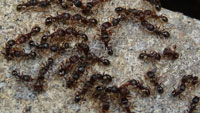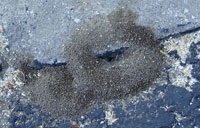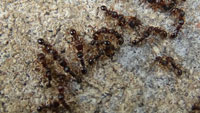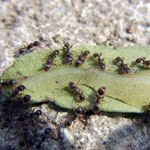What does the Pavement Ant look like? How can I recognize it?
 The Pavement Ant is from Europe. It is 2.5-4.0 mm long and about 2mm wide. It is dark brown, reddish brown or black. There are longitudinal parallel lines along its body. There are two spines on the thorax and there is a small sting at the end of the abdomen.
The Pavement Ant is from Europe. It is 2.5-4.0 mm long and about 2mm wide. It is dark brown, reddish brown or black. There are longitudinal parallel lines along its body. There are two spines on the thorax and there is a small sting at the end of the abdomen.
An easy way to recognize it is to squeeze its head. The pavement ant will be stunt for a few seconds if you press its head but will soon move again as if you had done nothing to it.
The Pavement Ant is present in in Quebec. It is classified among the invading type of ants.
Call an expert Ask an expert » Get a quick quote »Does the Pavement Ant represent any risk for me or my belongings?
The Pavement Ant has a small sting with venom. The sting is too small to pierce the skin. This ant is not aggresive and does not bite nor attack human.
The Pavent Ant multiplies quickly. The queen Pavement Ant can lay 20 eggs per day. The Pavement Ant has strong mandibles. It can move sand, dirt particles and damage interlock and cement.
The Pavement Ant can feed from insects, sweet, fat food and proteins. It can also contaminate pet food since this ant can carry bacetria from one site to another.
Call an expert Ask an expert » Get a quick quote »What are the signs of its presence?
 The Pavement Ant makes often its nest under big flat rocks, patio tiles, interlock, parking asphalt. It can also cause ground collapse under above ground pools. The Pavement Ant digs the dirt or sand and makes small mounds.
The Pavement Ant makes often its nest under big flat rocks, patio tiles, interlock, parking asphalt. It can also cause ground collapse under above ground pools. The Pavement Ant digs the dirt or sand and makes small mounds.
Its small size makes it easy for it to go in houses. The Pavement Ant passes through fundation cracks, weep holes, door threaholds, windows. Inside the house, it moves along the baseboards, under the carpet, in warmer rooms such as the kitchen, under heated ceramic floors. It is active even in the winter, in houses and buildings.
Call an expert Ask an expert » Get a quick quote »What to do if I have Pavement Ants?
 The Pavement Ant reacts in response to extreme temperature changes, strong rain, heatwave. One can observe migration of thousands of ants toward the inside of buildings.
The Pavement Ant reacts in response to extreme temperature changes, strong rain, heatwave. One can observe migration of thousands of ants toward the inside of buildings.



